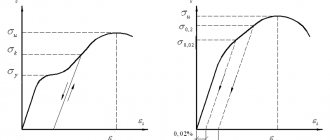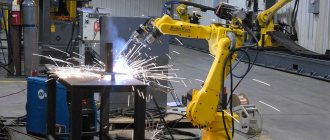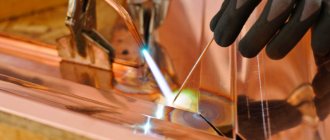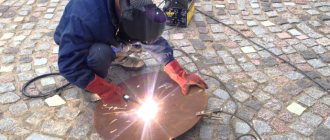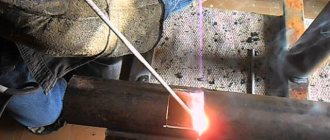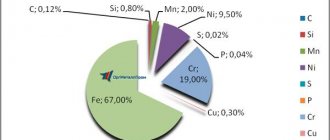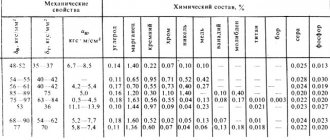Welding low alloy steels has found wide application in the manufacture of structures in construction. This is due to the fact that low-alloy structural steels have increased strength and, due to this, metal structures are lightweight and, therefore, more economical.
As a rule, the weldability of low-alloy structural steels is satisfactory. But, it is necessary to take into account that when the carbon content in the steel composition is more than 0.25%, there is a risk of the formation and development of hardening structures and hot cracks in the weld. In addition, other weld defects, such as the formation of pores, are likely to occur. And this happens due to carbon burnout during welding.
Marking features
Manufacturing standards and grades of low-alloy steels are determined by GOST 19282-73. It is used to work with rolled, wide-band, thick-sheet materials; the processing method is not important (it can be a shape, forging, stamping, etc.). Steel alloys are used in the construction of buildings, welding, assembling various structures, and in mechanical engineering.
According to GOST, the marking must indicate the following data:
- a group of numbers at the very beginning - indicates the percentage of carbon in steel;
- a letter for the alloying element, numbers indicating its percentage content (when less than 1%, the number is not indicated at all).
Example of marking on alloy 18ХГТ:
- carbon parts – 0.18%;
- manganese;
- chromium;
- titanium.
Since the numbers are not indicated, the remaining elements in the alloy are no more than 1%.
Common grades of low-alloy steels used in welding metal structures
Low-alloy steels, from which building structures are welded, contain no more than 0.25% carbon and no more than 3% alloying elements.
For the manufacture of metal structures for industrial and civil buildings, the most suitable steel grades are 15HSND, 14G2, 09G2S, 10G2S1, 10G2S1D, 16GS, 14G2AF, 16G2AF, etc.
Steel grades such as 18G2S, 25G2S, 35GS, 20KhG2Ts, etc. are well suited for the manufacture of welded gas pipes. The same grades are also used in the manufacture of reinforcement for reinforced concrete slabs.
Properties of alloys
Characteristics of the main alloying elements:
- Silicon is needed for alloying, it is inexpensive, the dependence of the hardness of the finished alloy on the volumetric inclusion of silicon in the composition is direct. The element is indispensable in the smelting of construction steels; it can be used with manganese and other components.
- Tungsten and molybdenum are needed to increase thermal resistance; they are used if the finished structures or products will be constantly operated at elevated temperatures.
- Vanadium is an important element in the complex alloying process; it makes it possible to obtain alloys with a uniform structure.
- Chromium is responsible for the resistance of steel to corrosion and the degree of its hardness. Titanium, nickel, and molybdenum increase stability; chromium can be replaced with these components.
- Copper is an element that is responsible for the degree of ductility of finished materials. There should not be too much of it, otherwise the alloy steel alloy will begin to stick to other working surfaces. For structural steels used in areas of high friction, this is a big disadvantage.
Also, low-alloy steels differ in types of processing. Thermal influences - tempering, hardening, tempering, normalization, they can be used in different combinations. Annealing parameters and weldability properties also differ.
To recognize the markings, you need to take into account the first letters used to designate the product range. Zh, X, E - this is a magnetic, chromium or stainless group. C – chromium-nickel, with pronounced stainless properties. Those alloys that are classified as high-speed, ball bearing alloys are designated as P or Sh.
A and Sh are high quality alloys. For normal quality such letters are not used. Materials produced by the rolling method have a special designation - this is TO or N, that is, heat treatment or cold hardening, respectively. The exact chemical composition of different brands is described in GOSTs and specialized literature. Understanding the basic principles of alloy marking will allow you to understand the composition of materials at the so-called household level.
High alloy
Highly alloyed alloys usually contain at least 16% chromium and at least 7% nickel, in addition to other impurities. Thanks to these and other additives, high-alloy alloys are highly resistant to low temperatures, corrosion and high temperatures.
But each brand has its own specialization, in which it has extreme characteristics. According to their purpose, high-alloy steels can be divided into heat-resistant, heat-resistant and corrosion-resistant.
After heat treatment they increase their strength and ductility. When hardened, their ductile properties improve.
Specificity
High-alloy alloys have such outstanding characteristics that they are used wherever the feasibility and price of the product allows.
But each specific product has different requirements. Accordingly, when carrying out welding work, different requirements for strength and ductility are imposed on welded seams, which leads to different approaches to welding work. That is, everything here is individual.
The presence of a large number of approaches in welding high-alloy steels is due to the fact that they have very specific thermophysical properties.
They have a low coefficient of thermal conductivity and a high coefficient of thermal expansion. In combination, they place conflicting demands on the welding process.
Low thermal conductivity leads to an increase in the depth of steel penetration. A high coefficient of thermal expansion causes deformation, including warping of parts. To reduce warping, it is necessary to concentrate thermal energy as much as possible. Laser welding does this well.
When manual electric welding of high-alloy alloys, the same measures are carried out as when welding medium-alloy alloys. The main task is to minimize the entry of hydrogen into the welding zone, otherwise it causes the appearance of pores and cracks.
Choice of technology
For high-alloy alloys, gas welding is not recommended for acid-resistant steels, as it causes intergranular corrosion. Even when heat-resistant steels are used in welding, warping of products occurs.
Submerged arc welding has great advantages over manual electric arc welding due to the fact that the welding process takes place under protection in a constant environment with the same components. There is no need to change electrodes, which causes crater formation.
Submerged arc welding ensures a uniform weld with specified characteristics due to the protection of the weld pool from the external environment in the form of hydrogen.
In addition, preliminary work is reduced, since cutting edges is only necessary for thicknesses of more than 12 mm, and manual arc welding requires cutting edges for metal thicknesses of more than 5 mm.
Laser welding is the most effective for alloy steels due to the high concentration of energy in a small area. This allows you to virtually eliminate warping and deformation. Many alloyed alloys can be welded together, regardless of type, only when using laser welding.
Where are low alloy steels used?
The use of low-alloy steels depends largely on their composition.
We will first consider main gas and oil systems. To construct them, we use the straight-seam electric welding method. The raw materials for the manufacture of products are mixtures with a low content of chromium and aluminum - up to a maximum of 0.3 and 0.05%, respectively.
13X steels are used for tools and special equipment. The calcination of the alloy is not very good; heat treatment above 250 degrees is not used.
To produce high-quality reinforcement for use in the construction industry, alloys of classes C, GS, KhGAYu, etc. are used. They are suitable for reinforcing reinforced concrete structures with different load-bearing parameters. To create reliable welded joints, it is optimal to use the types AFD, AFYu, GS. Complex buildings are made using alloys like 12KhGN2MFBAYU. The latter type of steel must first be hardened, then low tempered.
In mechanical engineering
- Manganese alloy 09G2 for creating frames, I-beams, and center-type beams. Operating temperature conditions – +450°.
- Manganese steel 10G2S1 for vessels and boilers that operate under pressure.
- Alloys with copper 10KhNDP are indispensable in the creation of complex machine-building structures.
- Manganese-copper low-alloy steel alloys types 12G2SMF can withstand any load and are indispensable in the construction of lightweight span structures.
A separate issue is the choice of steels for operation in constantly unfavorable conditions, that is, during precipitation and low air temperatures. Grades produced in accordance with GOST 19282 withstand such influences. Such steels are not afraid of corrosion, destruction, and are not subject to other negative changes.
Features of welding low-alloy steels
Welding of structural steels 15HSND, 15GS, 14G2, 14G2AF, 16G2AF
For welding low-alloy steel grades 15HSND, 15GS, 14G2, 14G2AF, 16G2AF, etc. Manual arc welding with E50A or E44A electrodes is well suited. But the highest quality welded joints are obtained when welding with UONI-13/55 and DSK-50 electrodes. But, the best results are obtained when welding with direct current with reverse polarity. At the same time, welding must be carried out at low currents, 40-50 A per millimeter of electrode diameter.
Automatic arc welding of these steel grades is performed using Sv-08GA or Sv-10GA welding wire under AN-348-A or OSTS-45 fluxes.
Metal structures made from steels 15HSND, 15GS, 14G2, 14G2AF, 16 G2AF can be welded at an ambient temperature of at least -10°C. If the ambient temperature is in the range from -10°C to -25°C, then preheating is necessary during welding. The heating width of the welding zone is 100-120 mm on both sides of the seam. Preheating temperature 100-150°C. At ambient temperatures lower than -25°C, welding of the above steels is not permissible.
Welding low-alloy steels 09G2S, 10G2S1, 10G2S1D
Assessment of the weldability of steel grades such as 09G2S, 10G2S1, 10G2S1D, etc. can be given a good one (see the table of weldability of steels), and this is due to the fact that they are not subject to hardening, are not prone to overheating and are resistant to the formation of hot and cold cracks in the weld and heat-affected zone. Welding of low-alloy structural steels of these grades can be performed either by manual or automatic arc welding.
For manual welding, electrodes of the E50A and E55A brands are well suited. For automatic welding, welding wire of the Sv-08GA, Sv-10GA or Sv-10G2 brands is used. To protect the welding zone, fluxes AN-348-A or OSTS-45 are used.
Welding of sheets made of steels 09G2S, 10G2S1, 10G2S1D, with a thickness of less than 40 mm, is carried out without cutting the edges. And, subject to the technology and welding conditions, the mechanical properties of the weld are almost as good as the mechanical properties of the base metal. The uniform strength of the weld is due to the transition of alloying elements from the electrode wire into the metal of the weld.
Phases
So, all steels are an alloy of iron and carbon, however, even general purpose steels have some amounts of manganese and silicon, as well as phosphorus and sulfur . Carbon in such steels is present at a level of 0.05 to 1.0%.
Iron is alloyed with carbon according to a special scenario; the mechanism of this alloy system is two-stage. The first stage is characterized by the combination of iron with 6.67% carbon, resulting in the formation of iron carbide, more often called cementite.
Therefore, ordinary steel at room temperature consists of cementite and ferrite. These are phases. If steel is heated to 725 degrees , then cementite dissolves in the iron and the next phase is formed - austenite. Any steel undergoes only three changes, while there can be many structures and mixtures thereof.
To main§ 36. WELDING TECHNOLOGY OF ALLOYED STEELS
Welding of low-alloy and medium-alloy structural steels.
The weldability of such steels depends on the content of carbon and alloying components and deteriorates with increasing content of carbon and alloying components.
Steels of the silicon-manganese group 15GS, 18G2S and 25G2S are welded with electrodes of the E60A type, grade UONI-13/65. Before welding, the edges are thoroughly cleaned of dirt, rust and scale. Welding is performed with an extremely short arc. Before welding, the product is heated to a temperature of 200 ° C, the electrodes are calcined at 400 ° C for one hour before welding. Silicon-manganese steels 10G2SD, 10KhGSND, 15KhSND and 12KhG are welded with electrodes of the E50A type, grade UONI-13/55. The product is not heated before welding. Welding of alloyed engineering steel.
Chromium steel 15X is welded with UONI-13/85 electrodes with an extremely short arc without heating and subsequent heat treatment. Chrome-molybdenum steel 15ХМ is welded with TsL-14 electrodes with preheating of the product to 250 - 300 ° C and subsequent high tempering at 710 ° C. ZOKhM grade steel is welded with TsL-30-63 electrodes with preheating of the product to 350 ° C and subsequent tempering at 600 ° C. Chrome-silicon-manganese steels 20KhGSA, 25KhGSA, ZOKHGSA, ZOKHGSNA are welded with TsL-18-63 or NIAT-ZM electrodes with an extremely short arc. After welding, the welded joints are subjected to heat treatment for high strength: hardening at a temperature of 880 ° C and low tempering. Technological characteristics of electrodes for welding some alloyed engineering steels are given in Table. 12.
Table 12
Technological characteristics of electrodes for welding some alloy steels
Welding heat-resistant steels.
Heat-resistant steels include 12MX;
20MHL; 34ХМ; 20ХЗМВФ; 20ХМФ; 20ХМФЛ; 12Х1М1Ф; 15ХМФКР; 12Х2МФБ; X5M; 15Х5МФА; X5VF; 06X13; X17; 1X13, etc. Products made of steels 12МХ and 20МХЛ, operating at temperatures up to 550° C, are welded with TsL-14 electrodes. Welding is performed with preheating of the product to 250 - 300° C for 20MKhL steel and up to 200° C for 12MKh steel. After welding, a high tempering is recommended at a temperature of 710° C. 12MX steel can also be welded with GL-14 electrodes if the product operates at temperatures up to 520° C. Heating and tempering are the same as when using TsL-14 electrodes. Products made from steels 34ХМ and 20ХЗМВФ, operating at temperatures up to 470° C, are welded with TsL-30-63 electrodes. Welding is performed with preliminary and concomitant heating of the product up to 350° C for steel 34ХМ and up to 400 - 450° C for steel 20ХЗМВФ. Welded joints are subjected to tempering: steel 34KhM - at a temperature of 600 ° C, steel 20KhZMVF - at a temperature of 680 ° C. Products made of steels 20KhMF, 20KhMFL, 12Kh1M1F, operating at temperatures up to 570 ° C, are welded with TsL-20-63 electrodes. Welding is performed with a short arc with preliminary and concomitant heating of the product to 300 - 350 ° C. After welding, a high tempering is recommended at 700 - 740 ° C for 3 hours
.
Products made from steels 15ХМФКР and 12Х2МФБ, operating at temperatures up to 600° C, are welded with TsL-26M-63 electrodes. Welding is performed with a short arc with preliminary and accompanying heating to a temperature of 350 - 400 ° C, and after welding, high tempering is performed at a temperature of 740 - 760 ° C. Products made of steels Kh5M and 15Kh5MFA, operating in aggressive environments at temperatures up to 450 ° C, are welded electrodes TsL-17-63 with preliminary and concomitant heating to 300 - 450 ° C and subsequent high tempering after welding at a temperature of 760 ° C for 3 hours
. Products made from steels Kh5VF, 06X13 and XI7 are welded with SL-16 electrodes. Technological data of electrodes for welding heat-resistant steels are given in table. 13.
Table 13
Technological characteristics of electrodes for welding heat-resistant steels
Welding of high-alloy corrosion-resistant, heat-resistant and heat-resistant steels and alloys.
In addition to the requirements for ultimate strength and ductility, welded joints of high-alloy steels and alloys are subject to other requirements, which are determined by the purpose of the structure and the properties of the metal being welded.
These requirements are as follows: for corrosion-resistant (stainless) steels - the ability to withstand intergranular, general liquid, knife and stress corrosion; for scale-resistant steels and alloys - the ability to resist scale formation and intergranular gas corrosion; for heat-resistant steels and alloys - ensuring long-term strength, creep resistance, microstructure stability, resistance to brittleness under prolonged exposure to high temperatures and loads and low sensitivity to notch and scale resistance. The main difficulties in welding high-alloy steels and alloys are: ensuring the resistance of welded joints against the formation of crystallization cracks, corrosion resistance, as well as maintaining the properties of joints under the influence of operating temperatures and stresses. Welding of corrosion-resistant steels.
Corrosion-resistant steels include 0Х18Н10Т, 0Х18Н10Т, Х18Н10Т, Х18Н9, Х18Н9Т, 0Х18Н12Т, 0Х18Н12Б, 1Х21Н5Т, 1Х16Н13Б, Х18Н12Т, etc. Steels 0Х18Н10Т, 0Х18Н10 and Х18 N10T is welded with OZL-14 electrodes if the weld metal is required to be resistant to intergranular corrosion. Welding with these electrodes ensures a ferrite phase content of 6-10% in the weld. Steels Kh18N9, Kh18N9T are welded with OZL-8 electrodes if the weld metal does not require resistance to intergranular corrosion or if the welded joint will be operated at temperatures up to 350 ° C (in the absence of aggressive environments - at temperatures from 253 to 800 ° C). The ferrite phase content in welds ranges from 3.5 to 8.5%. Steels Х18Н10Т, Х18Н9Т, 0Х18Н12Т, 0Х18Н12Б, 1Х21Н5Т, 1Х16Н13Б are welded with TsL-11 electrodes if the weld is subject to strict requirements for resistance to intergranular corrosion. The ferrite phase content in welds is ensured from 2.5 to 7%. X18N12T steel is welded with TsT-15-1 electrodes (root weld), the welded joint will be operated at a temperature of 600 - 650 ° C and high pressure. The ferrite phase content in welds ranges from 5.5 to 9%. Steels Kh18N10T, Kh18N9T are welded with ZIO-3 electrodes if the welds will be operated at temperatures up to 560 ° C or if requirements for resistance against intergranular corrosion are imposed on the weld metal. The content of the ferrite phase in the weld is regulated from 2.5 to 5%. Technological properties of electrodes for welding corrosion-resistant steels are given in table. 14.
Table 14
Technological characteristics of electrodes for welding corrosion-resistant steels
Welding of heat-resistant steels.
This group of steels includes X25T, X28, X23N18, X23N13, X20N14S2, X25N20S2, etc. X25T and X28 steels are welded with OZL-6 electrodes if the welded products will be operated at a temperature of 1150°C (without cyclic sudden changes and in environments that do not contain sulphur dioxide). Welding is performed with a short arc. The edges are prepared for welding only mechanically. The ferrite phase content is regulated from 2.5 to 10%. Steels X23N18, X25T and X28 are welded with TsL-25 electrodes if the welded products will be operated at temperatures above 850° C. Welding is performed with rollers having a width of no more than three electrode diameters. Craters are filled with frequent short circuits. The ferrite phase content is regulated from 3 to 9%. Steels X25T, X28, X23N13, X23N18, which are in operation at temperatures of 900 - 1100 ° C, are welded with OZL-4 electrodes. Welding is performed with an extremely short arc. The edges are processed for welding only mechanically. The ferrite phase content is regulated from 2.5 to 8%. Steels X23N18, X23N13, which are in operation in oxidizing and carburizing environments at temperatures of 900 - 1050 ° C, are welded with OZL-9A electrodes. When welding these steels, it is especially necessary to ensure that cracks do not appear in the craters. There is no ferrite phase and is not standardized by GOST. Welds are not resistant enough to intergranular corrosion. Steels X20N14S2, X25N20S2, operating at temperatures up to 1050 ° C, are welded with GS-1 electrodes (first layer). Heat resistance of the deposited metal up to 1150°C. Steels X20N14S2, X25N20S2, operating at temperatures of 900 - 1100 ° C, are welded with OZL-5 electrodes. Edges are prepared for welding only mechanically. The welds are resistant to hot cracking. Kh20N14S2 steel, which is in operation at temperatures of 900 - 1100 ° C, can also be welded with TsT-17 electrodes when applying seams of small width - no more than 3 electrode diameters. Technological characteristics of electrodes for welding heat-resistant steels are given in table. 15.
Table 15
Technological characteristics of electrodes for welding heat-resistant steels
Welding of heat-resistant steels and alloys.
Steels of this group include 1Х16Н14В2БР, 1Х16Н16В2МБР, 1Х14Н14В2М, 4Х14Н14В2М, 1Х16Н13М2Б, 1Х14Н14В2М, Х18Н12Т, Х23Н13, Х23Н18, ХНЗБВТ and others. Steels 1Х16Н14В2БР and 1Х16Н16В2МБР is welded with TsT-16-1 electrodes.
Craters are sealed by short-circuiting the electrodes. The same steels are welded with TsT-16 electrodes if the products are operated at temperatures up to 700°C. Steels 1Х14Н14В2М and 4Х14Н14В2М, operating at temperatures up to 600°C, are welded with TsT-1 electrodes. The welds are resistant to hot cracking. Steels 1Х16Н13М2Б, 1Х14Н14В2М and Х18Н12Т, operating at temperatures up to 620°С, are welded with TsT-7 electrodes. Hot cracks in welds are eliminated by achieving a ferrite phase of 2 to 5%. After welding, annealing is used at 750 - 800 ° C for 10 hours
. Steels X23N13, X23N18, operating at temperatures up to 1050° C, are welded with OZL-9 electrodes. Fire preparation of edges for welding is not allowed. When multilayer welding, seams must be made with OZL-9 electrodes through a layer deposited with OZL-4, OZL-5, OZL-6 and GS-1 electrodes. Iron-nickel alloys KhN35VT are welded with KTI-7-62 electrodes. Technological characteristics of electrodes for welding heat-resistant steels and alloys are given in table. 16.
Table 16
Technological characteristics of electrodes for welding heat-resistant steels and alloys
Self-test questions
1. What are the features of welding low-alloy structural steels?
2. Why do alloy steels need to be welded with a short arc? 3. What is the peculiarity of welding heat-resistant steels? Previous page
| table of contents | Next page |
